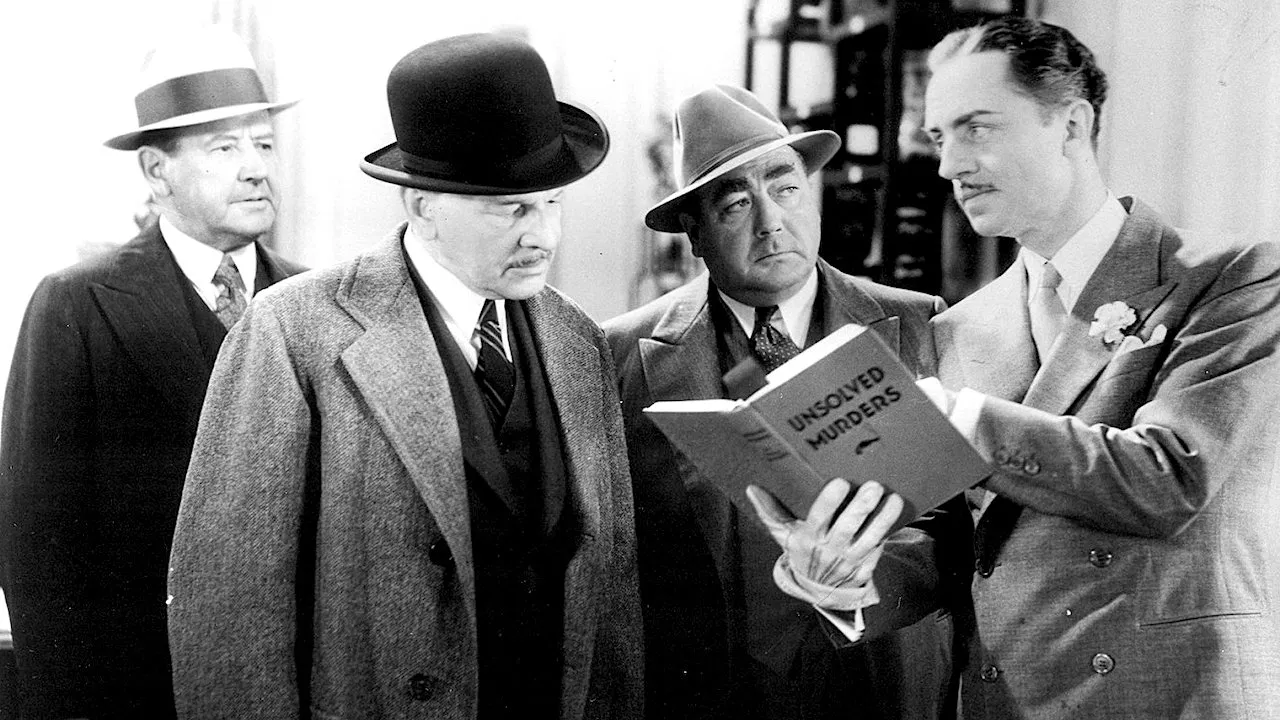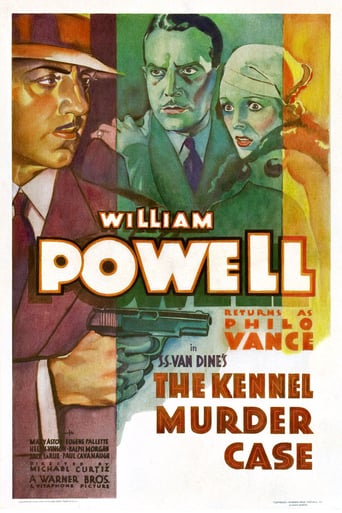

Most undeservingly overhyped movie of all time??
... View MoreDreadfully Boring
... View MoreFanciful, disturbing, and wildly original, it announces the arrival of a fresh, bold voice in American cinema.
... View MoreGood films always raise compelling questions, whether the format is fiction or documentary fact.
... View MoreIf this is one of the better Philo Vance films of the era, I'm not sure I would want to watch any of the others. The usual whodunit theme applies here. A detestable person gets murdered; there's a house full of suspects; police are baffled, but a lead detective sees clues that the police don't see and solves the crime.The film has some good points. All the suspects are well defined; no wondering whether person x or y should or should not be considered a suspect, as with some whodunits. The script here is thus clear and concise, and with just the right number of suspects ... not too many and not too few. Also, I like the segment near the end, before the reveal, wherein we get to see a re-creation of the actions of the killer, whose darkened shadow is shown, thus concealing the identity of the murderer.But overall I find this film slightly disappointing, given its fine reputation. The plot seems rushed. There's an absence of spine-tingling suspense. Detective Philo Vance is dull and uninteresting; I prefer a detective with some quirks and idiosyncrasies like we find with Charlie Chan and Hercule Poirot. And William Powell, as Vance, is no Sidney Toler or Peter Ustinov.Finally, I try to make some allowance for production quality of that era. But unlike other films from the 1930s, the photography and sound here are not very good, at least in the copy I watched. Set design is minimal and cheap looking."The Kennel Murder Case" has a good reputation as 1930s whodunits go. Maybe I was expecting too much. It's not a bad movie, and viewers can still enjoy the film if they keep their expectations subdued.
... View More"The Kennel Murder Case" is often regarded as the best of all the Philo Vance films, but having seem many of them in the last few months I don't think the quality gap between "Kennel" and most of the others is that big; in fact, I think "The Casino Murder Case" is just as good as this film, if not better. That does not mean, however, that "Kennel" is not a clever and engrossing whodunit - it is. (Heavy spoilers follow - do not read if you have not seen the film) The idea of two killers separately plotting the murder of the same man and having their plans interrupted by each other is a unique one, especially for the time, and the mystery is a real head-scratcher. The ending, however, is not as strong as the rest of the movie: after describing in perfect detail the "how" and "when" of the crimes, Vance admits that he has no idea as to the "who" - and yet, a few seconds later, he pulls the killer's identity out of his hat and devises a not-so-foolproof plan to expose him. A better idea might have been to have all the suspects assembled and have the dog, with whom the killer had a previous encounter, sniff him out. The entire (large) cast is solid, and Michael Curtiz's direction features some advanced camera work. *** out of 4.
... View MoreThis is the sixth Philo Vance mystery film and the fifth and last starring William Powell, five films which he made between 1929 and 1933. (In 1930 a single Philo Vance film intervened which starred Basil Rathbone, THE BISHOP MURDER CASE, see my review). After this, Philo Vance was played by eight different actors until 1947, when the series ended (it had gone into abeyance during the War, between 1940 and 1947). Here William Powell continues to become more and more recognisable as the William Powell we all admire from his later films. Although the script gives him little opportunity, he still manages to make the occasional comment with the typical Powellesque mixture of nonchalance and challenge. Insouciance is never that far away, and one can sense it trembling on his lips. His sense of humour peeks through the workmanlike script from time to time, like a mouse glancing through its hole at a cheese on the table but not daring to try to approach it. (A whole cheese of the old-fashioned kind bears a certain resemblance to a director's cut, doesn't it? It is more nearly what its Maker intended.) This film has many characters, including seven murder suspects. The plot is convoluted, there is more than one murder, and there may even be more than one murderer. A central feature of the complex plot is that old chestnut, the murder in a locked room which is bolted from the inside. In this film, unlike others one could mention, we see a detailed and closeup view of just how that trick is done. I am not aware of when the famous motif of a murder in a sealed and bolted room first entered detective fiction, and doubtless experts in the genre might have some idea. But here we have it on screen in 1933, and trackers of ingenious plot twists can add that as one of the early dots which they join in their graph. But there are many red herrings and other complications in this tale. There may be not one, not two, but three murder weapons, for instance. Which one did the deed? Why are there so many? The sub-plot of a Chinese cook who is really a Columbia University graduate specializing in the acquiring of rare porcelain adds a further twist. Certainly this story was very meticulously plotted, with as many intersecting possibilities as a well-cut jewel has facets. It gleams from all angles, and the answers may come from more than a single one. Detective story lovers will not be disappointed. Mary Astor is one of the two female stars, but has little to do other than walk through her lines. This is a plot film, not a character film, and nothing matters but whodunit, or whodunn'em. There are no wisecracks or smart dialogue in this film, but it does have a running humorous sub-plot of the coroner whose meals keep being interrupted as he is repeatedly summoned to check on more bodies, and he gets grumpier and grumpier. He is very funny, and this lightens the film up a little. The film never rises above the mediocre except in its plot elements. Oh yes, there are cute dogs in this film. In most films, we get cute girls, but in this one we get cute dogs.
... View MoreThe Kennel Murder Case is one of those rare films that show everyone involved at the best of their craft, and working well together to give a good show. It is well worth watching for story, characters, and an odd nostalgia that comes from reflecting on the police procedural drama, from then and today. From the threat of physical violence from the lead police officer, to a district attorney being directly involved in a criminal investigation, you can add to the fun of a good movie by asking yourself "What could they do now, and what did they do wrong in the picture?" Again I love this film and have watched in many times, but some of the little anachronisms are like wonderful Easter Eggs.Little things spring up SPOILER ALERT throughout the film. Despite a mob of police, nobody searches the house which is the scene of the crime. Suspects are allowed to live in the house which is the scene of two murders, a possible burglary, and an ongoing investigation. Vance is allowed to take over a police investigation without any more authority than being a friend of the District attorney. There are architectural models made in what seems like hours that have an extraordinary level of detail; in fact they are probably the models used for some of the incredible camera shots throughout the film.Speaking of the camera work, it is inspired. With all the murder mysteries filmed at this time based on stage plays, with a resulting flat camera work, this movie makes the camera almost a character in itself. I wish someone would spend the money and restore this film. I can think of at least three films of Powel's that should be cleaned up for this generation.However you chose to watch this film, as a story, acting, cinema photography, or just as a good whodunit, you won't go wrong by watching this pleasing picture.
... View More